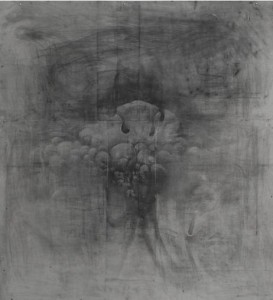Woodward’s poetics
Matt Woodward, an emerging Chicago artist, does graphite-on-paper drawings that thrive in the rich Middle Way between abstraction and representation, past and present, large and small, classicism and expressionism—pick almost any pairing of opposites and Woodward merges them with great originality. His method, so far, is obsessively invariant: he wanders a city, captures an overlooked architectural detail from an earlier decade–well, century–back when ornament and pattern were considered essential to our living space. He hunts for a finial, a fleur de lis, some overlooked niche of architecture—and then he creates a meticulous representation of these shapes through techniques that imbue the image with an evocative ambiguity. He sands and punishes huge sheets of paper, creating a surface full of unpredictable characteristics—which he sometimes assembles, like a puzzle, as Burchfield used to do—into panels large enough to use, in a pinch, as drywall for a large bedroom. Then he coats them with graphite dust, and finally, he draws by erasing the shapes he wants to show. It’s a brilliant inversion that goes to the heart of how time itself works: erasing what it is you want to see. What he achieves can evoke a slightly Faulknerian longing for ancient values, a world of allegiance to something more chivalrous than our media-drugged days, and yet the work has an immediacy, precision and freshness that feels entirely new. The vitality of his drawings derive from this paradoxical tension between extremes. The details are assiduously evoked, to the point where they actually shine, and yet you can’t quite pin down what it is you’re seeing—and so your mind shuttles desperately from one tentative sense of closure to another, not quite settling on a secure way to make sense of what he’s showing. He makes you dream, involuntarily, as part of this struggle to recognize what it is you’re on the way to seeing.
When I saw one of his wall-size triptychs two years ago in Rochester, NY, the effect was what Gaston Bachelard celebrated as the “oneiric” effect of certain spaces, which he equated with the half-conscious reverie induced by poetry. What had been a small cluster of grapes carved into the stone of an historic structure, though the alchemy of Woodward’s techniques, seemed to become a dreamscape, a circle out of Dante or a scene from Edgar Rice Burroughs. It was as much a vision of a physical world as an objective correlative for indeterminate psychological and emotional states. Woodward told me recently that he’d finished the work during a time of mourning over the death of his father—and his abiding preoccupation with the passage of time, had become, with his father’s death, agonizingly central to his emotional life. Art itself began as a desperate bid to hang onto something one loves, to steal it from time and save it through concentrated attention and representation, and Woodward work taps these motives. His work’s beauty is inseparable from a melody of grief that makes it come alive.

Comments are currently closed.